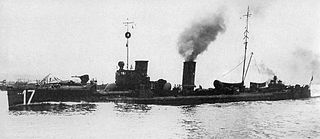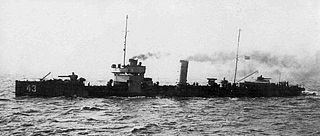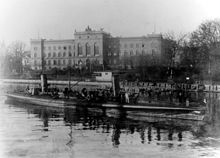
The A-class torpedo boats were a class of German single-funnelled torpedo boat/light destroyer designed by the Reichsmarineamt for operations off the coast of occupied Flanders in the First World War. The "A" designation was to avoid confusion with older classes and designs. They were classed officially as "coastal torpedo boats" to differentiate from larger, ocean-going torpedo boats.
The German torpedo boats of World War II were armed principally, if not exclusively, with torpedoes and varied widely in size. They were not small schnellboote but small seagoing vessels, the larger of which were comparable to destroyers. During World War II, German torpedo boats were administratively grouped into several torpedo-boat flotillas.

Italian torpedo boat Premuda was a 1916 Type Large Torpedo Boat of the Imperial German Navy during World War I. Built as SMS V116 she was the first ship of her class to be launched.

The French destroyer Amiral Sénès was a 1916 Type Large Torpedo Boat of the Imperial German Navy during World War I. Built as SMS S113 she was the first ship of her class to be laid down, but the second and final ship of her class to be launched.

SMS S36 was a 1913 Type Large Torpedo Boat of the Imperial German Navy during World War I, and the 12th ship of her class. She was equipped with of three single mounted 8.8 cm SK L/45 naval guns and with six 50 cm (19.7 in) torpedo tubes, two forward and four aft; twenty-four mines could also be carried. She was launched on 17 October 1914 and commissioned on 4 January 1915. S36 took part in the Battle of the Gulf of Riga in 1915 and the Battle of Jutland in 1916. In late 1916 she served in the English Channel and took part in a number of engagements, including the Battle of Dover Strait during which a British merchant ship and a destroyer were sunk by her Half-Flotilla. She was scuttled at Scapa Flow in 1919.

The V25 class was a class of torpedo boat built for the Imperial German Navy. It was numerically the largest class ever built for the High Seas Fleet, consisting of 71 ships. Of the class, 32 were sunk during World War I, several to mines in the North Sea and Baltic Sea. Of those that survived the war 29 were scuttled with the German fleet at Scapa Flow, one was destroyed by a mine on the way there, four were given to Britain and were not scuttled while one was given to Italy and France.

SMS S35 was a 1913 Type Large Torpedo Boat of the Imperial German Navy during World War I. She served at the Battle of Jutland where she was sunk by British battleships.

SMS S115 was a S90-class torpedo boat of the Imperial German Navy that served during the First World War. The ship was built by Schichau at Elbing in Prussia, and was completed in February 1903. The ship was sunk during the Battle off Texel on 17 October 1914.

SMS S119 was a S90-class torpedo boat of the Imperial German Navy that served during the First World War. The ship was built by Schichau at Elbing in Prussia, and was completed in September 1903. The ship was sunk during the Battle off Texel on 17 October 1914.

SMS S90 was a torpedo-boat of the Imperial German Navy. She was built by Schichau at Elbing as the lead ship of her class, completing in 1899.

The German torpedo boat T2 was one of a dozen Type 35 torpedo boats built for the Kriegsmarine during the late 1930s. Completed in 1939, she was not combat ready until mid-1940, when she spent several months escorting minelayers as they laid minefields. The boat returned to Germany after being damaged and supported operations in the Baltic Sea after the start of Operation Barbarossa in June 1941. T2 returned to France at the end of the year, escorting a commerce raider through the English Channel. She then escorted a pair of battleships and a heavy cruiser through the Channel back to Germany in early 1942 in the Channel Dash. The boat was placed in reserve upon her return and was transferred back to France in 1943, where she helped to escort blockade runners through the Bay of Biscay. In mid-1943, she returned to the Baltic and briefly served as flagship of a submarine flotilla before being assigned to the Torpedo School. T2 was sunk in an air raid in July 1944, but was refloated several months later. She was never repaired and eventually scrapped in 1946.
SMS S32 was a V25-class large torpedo boat of the Imperial German Navy that served during the First World War. She was built by the Schichau-Werke shipyard in Elbing, East Prussia, being launched on 28 February 1914 and was completed in September that year.
SMS S13 was a V1-class torpedo boat of the Imperial German Navy. The ship was built by Schichau-Werke, at their Elbing shipyard, completing in 1912. She served in the First World War with the German High Seas Fleet, taking part in the Battle of the Heligoland Bight in 1914. She was sunk by an accidental explosion on 6 November 1914.
SMS S116 was a S90-class torpedo boat of the Imperial German Navy that served during the First World War. The ship was built by Schichau at Elbing in Prussia, and was completed in March 1903. The ship was torpedoed and sunk by the British submarine E9 on 6 October 1914.
SMS S15 was a V1-class torpedo boat of the Imperial German Navy. The ship was built by Schichau-Werke, at their Elbing shipyard, completing in 1912.
SMS S16 was a V1-class torpedo boat of the Imperial German Navy. The ship was built by Schichau-Werke, at their Elbing shipyard, completing in 1912. S16 served with the German High Seas Fleet during the First World War, taking part in the Battle of Jutland in 1916. She was sunk by a mine on 20 January 1918.

SMS S17 was a V1-class torpedo boat of the Imperial German Navy. The ship was built by Schichau-Werke, at their Elbing shipyard, completing in 1912. S17 served with the German High Seas Fleet during the First World War, taking part in the Battle of Jutland in 1916. She was sunk by a mine on 16 May 1917.

SMS S18 was a V1-class torpedo boat of the Imperial German Navy. The ship was built by Schichau-Werke, at their Elbing shipyard, completing in 1912. S18 served with the German High Seas Fleet during the First World War, taking part in the Battle of Jutland in 1916. S18 survived the war, serving in the Weimar Republic's Reichsmarine. She was scrapped in 1935.

SMS S19 was a V1-class torpedo boat of the Imperial German Navy. The ship was built by Schichau-Werke, at their Elbing shipyard, completing in 1913. S19 served with the German High Seas Fleet during the First World War, taking part in the Battle of Jutland in 1916. The ship survived the war, serving in the Weimar Republic's Reichsmarine. She was scrapped in 1935.

SMS S143 was a S138-class large torpedo boat of the Imperial German Navy. The S138-class were large torpedo boats that were required to reach a speed of 30 kn and armed with three 45 cm torpedo tubes. S143 was built by the Schichau-Werke at Elbing and was launched on 6 April 1907, entering service later the same year.
























